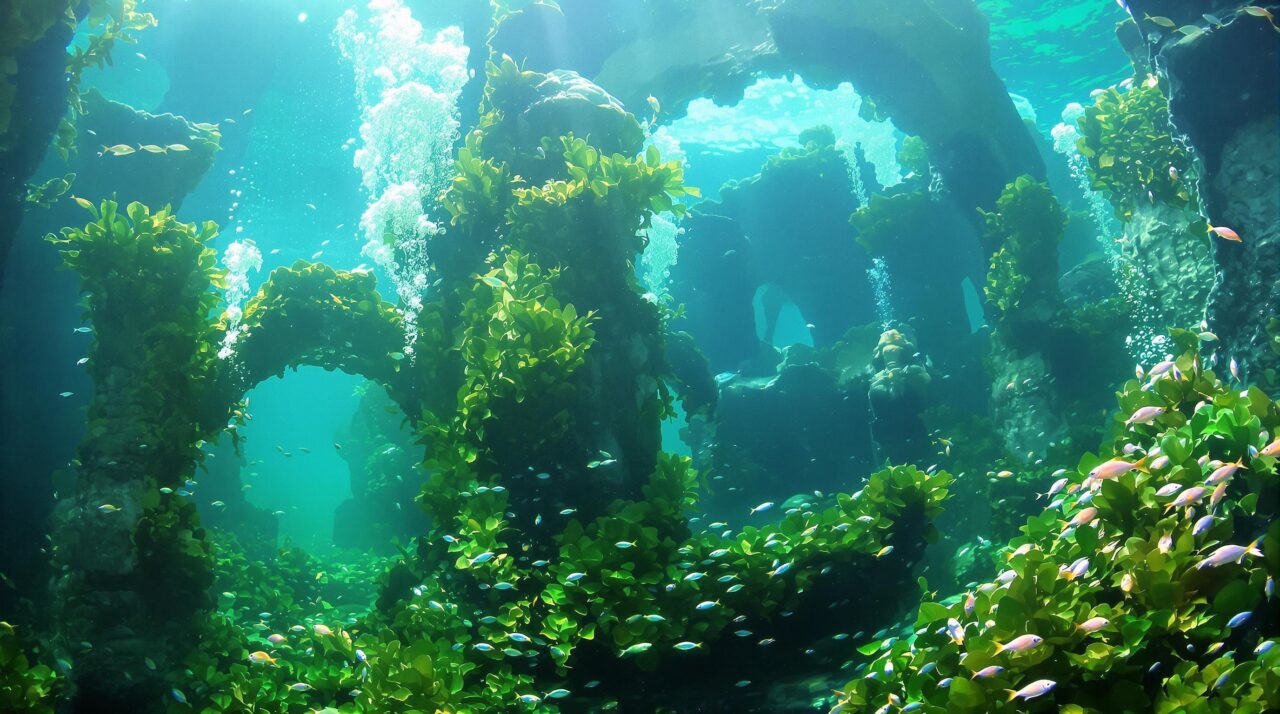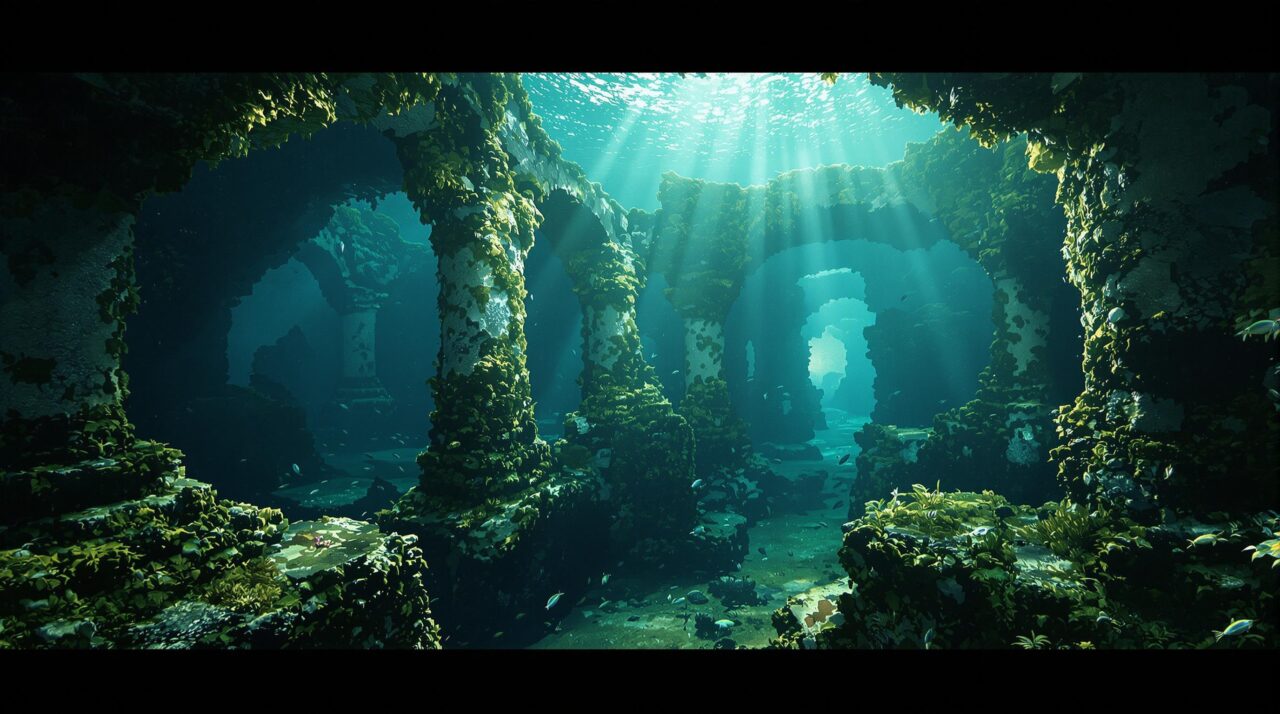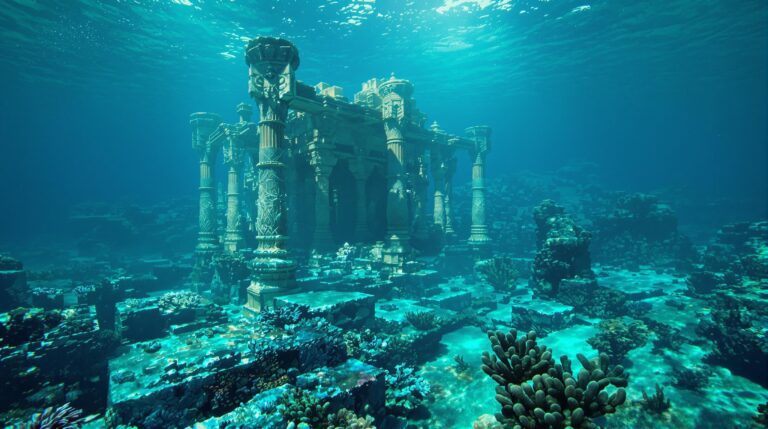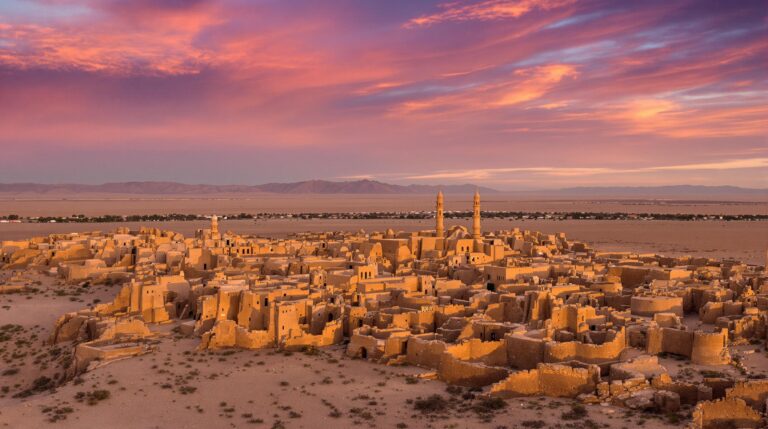Vineta: The Sunken City of the Baltic Sea

Vineta, often referred to as the Northern Atlantis, captivates with its blend of myth and reality.
Historical accounts describe it as a bustling trade center, yet its exact location remains elusive.
The city’s fall raises questions about human ambition and the forces of nature. What led to its demise?
As researchers explore underwater clues and ancient tales, the enduring fascination with Vineta prompts deeper inquiries into our understanding of lost civilizations.
What secrets lie beneath the waves?
TL;DR
Hide- Vineta is a legendary sunken city in the Baltic Sea, tied to medieval chronicles and folklore from coastal communities in Poland and Germany.
- The city's prosperity stemmed from its role as a bustling trade hub, fostering cultural exchange and technological advancements.
- Vineta's disappearance is attributed to natural disasters, human conflicts, and moral allegories warning against hubris and greed.
- The legends of Vineta reflect shared cultural identities, blending pagan and Christian elements across Baltic communities.
- Modern interpretations of Vineta include festivals and museums, highlighting its significance in regional heritage and the cautionary themes of its narrative.
Vineta: Ancient Stories of a Northern Atlantis

The earliest references to Vineta emerge from medieval chronicles, sparking curiosity about its legendary existence as a northern Atlantis.
These accounts, steeped in mystery, intertwine with folklore that has been passed down through generations, revealing cultural beliefs and fears surrounding the lost city.
Analyzing these narratives invites questions about the intersection of history and myth, and what truths may lie beneath the waves of time.
The First Mentions of Vineta in Medieval Chronicles
The earliest mentions of Vineta in medieval chronicles by figures such as Adam of Bremen and Helmold of Bosau paint a vivid picture of a city steeped in wealth and power, often described as embodying an almost mythical arrogance.
These accounts raise intriguing questions about the societal values of the time and the allure of a lost civilization reminiscent of Atlantis.
How did these narratives shape the perception of Vineta, and what truths might lie behind the legendary tales of its grandeur and eventual demise?
Accounts by Adam of Bremen and Helmold of Bosau
While exploring the medieval chronicles, one encounters the intriguing accounts of Vineta by Adam of Bremen and Helmold of Bosau, both pivotal figures in the historical documentation of this enigmatic sunken city.
Their narratives weave a tapestry of myth and reality, prompting questions about its origins and significance.
These early mentions spark curiosity, inviting further exploration into the allure of Vineta’s legendary past.
Descriptions of Wealth, Power, and Arrogance
Medieval chronicles paint a vivid picture of Vineta, often depicting it as a city overflowing with wealth, power, and an unmistakable sense of arrogance.
These narratives suggest a society captivated by opulence, where riches fostered hubris. The rulers, ensconced in luxury, seemed blind to the impending consequences of their pride, prompting reflection on the balance between prosperity and humility in human endeavors.
Folklore Passed Down Through Generations
Folklore surrounding Vineta reveals a complex web of oral traditions cherished by coastal communities, each story echoing the city’s mysterious demise.
Central to these narratives are themes of divine punishment and hubris, where the once-flourishing civilization is often depicted as a cautionary tale for future generations.
Also read:
How do these ancient stories reflect the values and fears of the societies that passed them down?
Oral Traditions from Coastal Communities
As coastal communities have thrived along the shores of northern Europe, they have woven rich tapestries of oral traditions that echo the mysteries of lost civilizations, such as the legendary Vineta.
These stories, often steeped in vivid imagery and local lore, serve as cultural touchstones, reflecting the hopes, fears, and identities of those who recount them, inviting curiosity about their origins and meanings.
Themes of Divine Punishment and Hubris
The legends surrounding Vineta often intertwine with themes of divine punishment and human hubris, presenting cautionary tales that resonate through generations.
These stories reflect humanity’s struggle against arrogance, illustrating how the city’s wealth and pride ultimately led to its downfall.
The submerged ruins serve as a poignant reminder of the consequences of overreaching, urging future generations to maintain humility and respect for nature’s power.
Geography and Speculation: Where Was Vineta?
The search for Vineta’s whereabouts invites scrutiny of the shifting Baltic coastline, which has transformed the region’s geography over centuries.
Various candidate sites emerge, each accompanied by their own local myths that echo the narrative of a submerged civilization.
This interplay between geography and folklore raises questions about how landscapes shape legends and the enduring quest to locate the fabled city.
The Shifting Baltic Coastline and Candidate Sites
The shifting Baltic coastline presents a complex landscape for the search for Vineta, with Wolin Island, Usedom, and Barth emerging as prominent candidate sites.
Rising sea levels and coastal erosion challenge traditional narratives, prompting speculation about the city’s original location and its eventual submergence.
As historical and geographical evidence intertwine, the debate intensifies over where this legendary city may have truly existed.
Wolin Island, Usedom, and Barth as Possibilities
Numerous theories abound regarding the potential locations of Vineta, with three prominent candidates being Wolin Island, Usedom, and Barth.
Each site offers unique geographical features and historical contexts that fuel speculation. Wolin Island’s rich folklore, Usedom’s strategic coastal position, and Barth’s historical significance as a trading hub present intriguing possibilities, inviting exploration into how these areas might connect to the legendary sunken city.
How Rising Seas and Erosion Shape the Debate
Geographical changes along the Baltic coastline greatly influence the ongoing debate about Vineta’s location. Rising sea levels and relentless erosion reshape the landscape, obscuring potential sites.
As the shoreline retreats, historians and archaeologists grapple with shifting evidence, questioning whether traditional sites still hold merit. This dynamic interplay of nature and speculation invites a reevaluation of Vineta’s legacy, compelling a search for truth beneath the waves.
Myths Rooted in Moving Landscapes
The legends surrounding Vineta are intricately tied to the dynamic nature of the Baltic Sea, where storm surges and potential tsunamis may have reshaped coastlines and submerged harbors.
As waterways shifted, the myths of this elusive city flourished, prompting speculation about its true location.
Could the stories of Vineta be reflections of real events, rooted in a landscape constantly transformed by nature’s forces?
Influence of Storm Surges and Tsunamis
While many legends speak of Vineta as a grand city swallowed by the sea, the geological forces of storm surges and tsunamis provide a plausible backdrop for the myth’s origins.
Historical records reveal that violent storms and seismic activity have reshaped coastal landscapes, potentially leading to the submersion of thriving settlements, thereby intertwining fact with folklore in the enigmatic tale of Vineta.
Lost Harbors and Changing Waterways
Often shrouded in mystery, the search for Vineta’s true location has led scholars and enthusiasts alike to examine the shifting landscapes of ancient coastlines.
Lost harbors, once lively with trade, have succumbed to the relentless advance of water and time. Changing waterways challenge the narrative of stability, inviting speculation about Vineta’s fate and the cities that may lie beneath the waves, waiting to be rediscovered.
What Made Vineta So Prosperous in Legend?
Vineta’s legendary prosperity is often attributed to its status as a bustling hub of trade and maritime power, with merchants flocking to its shores.
The city is also rumored to have boasted remarkable technological advancements and architectural feats that set it apart from contemporary civilizations.
What factors truly contributed to its legendary success, and how did these elements intertwine to create a thriving metropolis?
A City of Merchants and Maritime Power
Vineta’s legendary prosperity as a city of merchants stemmed from its pivotal role in global trade, where diverse cultures converged and exchanged goods and ideas.
This lively economic environment was further enriched by a tapestry of religious diversity, which fostered a unique societal fabric that attracted various populations.
Additionally, Vineta’s political independence allowed it to navigate the complexities of maritime power, positioning the city as a formidable player in regional commerce.
Descriptions of Global Trade and Cultural Blending
Although many legends surround Vineta, its portrayal as a hub of global trade and cultural blending stands out, highlighting its significance as a maritime power in ancient times.
This bustling city attracted diverse merchants, fostering exchanges of goods, ideas, and traditions. Such interactions not only enriched Vineta’s economy but also forged a unique cultural identity, enchanting those who sought freedom and connection across distant lands.
Religious Diversity and Political Independence
Religious diversity played an essential role in shaping the prosperity of the legendary city, serving as a magnet for various communities seeking refuge and opportunity.
This melting pot fostered:
- Innovative trade practices.
- Cultural exchanges that enriched local traditions.
- Political independence, allowing for self-governance.
- A thriving economy driven by collaboration.
Such dynamics underscored Vineta’s allure as a beacon of freedom and prosperity.
Alleged Technological and Architectural Marvels
The legends surrounding Vineta often highlight its extraordinary wealth, characterized by abundant gold, silver, and exotic goods that flowed through its bustling markets.
Architectural wonders, including grand palaces, elaborately designed temples, and imposing fortifications, contributed to its reputation as a marvel of engineering and artistry.
What specific innovations and designs might have enabled such prosperity, and how did they reflect the city’s status in ancient maritime trade?
Riches of Gold, Silver, and Exotic Goods
Legend envelops Vineta, the sunken city, in tales of untold wealth and remarkable ingenuity.
What treasures fueled its prosperity?
- Gold coins, glimmering with promise.
- Silver vessels, intricately crafted.
- Exotic spices, traded from distant lands.
- Rare textiles, symbols of luxury.
These riches, woven into Vineta’s narrative, create an alluring image of a thriving hub where every street whispered secrets of abundance and innovation.
Palaces, Temples, and Towering Fortifications
Amidst the tales of Vineta’s splendor, its architectural achievements stand as a tribute to the ingenuity of its people.
Palaces adorned with intricate carvings, temples dedicated to deities, and towering fortifications symbolize a society thriving on innovation.
What engineering marvels enabled their construction?
Could the advanced techniques of Vineta’s builders have influenced neighboring cultures?
Such questions linger, fueling the allure of this submerged legend.
Tales of Destruction: How Did Vineta Disappear?
The disappearance of Vineta invites questions surrounding the causes of its destruction, ranging from moral allegories to the consequences of human conflict.
Was the city a victim of natural forces, or did its own hubris lead to its downfall?
Exploring these narratives reveals a complex tapestry of myth and reality that begs further investigation.
Moral Allegories and Mythic Retribution
The tale of Vineta’s disappearance raises questions about the consequences of human hubris, particularly as it relates to greed and arrogance.
How did the city, once thriving, fail to heed the dire warnings that foreshadowed its doom?
This narrative serves as a compelling moral allegory, suggesting that the sins of a community can invoke divine retribution, leading to catastrophic outcomes.
Divine Wrath for Greed and Arrogance
Long ago, Vineta flourished as a beacon of prosperity, its grand architecture and lively culture reflecting the heights of human achievement.
Yet, this opulence masked a deeper truth, as divine retribution loomed. The city’s downfall can be attributed to:
- Unchecked greed among its leaders
- Disregard for the common folk
- Arrogance in the face of nature
- Ignorance of moral boundaries
Such hubris invited calamity.
Sins of a City That Ignored Warnings
While the citizens of Vineta reveled in their material wealth, ominous signs of impending doom were often overlooked, prompting questions about the city’s collective consciousness.
Ignored warnings of environmental shifts and whispered prophecies reflected a profound disregard for balance.
This negligence, woven into the fabric of Vineta’s society, ultimately beckoned retribution, as the city’s arrogance spiraled into its own demise beneath the waves.
Natural Forces or Human Conflicts?
The disappearance of Vineta prompts questions about the interplay between natural disasters and human actions.
Historical records indicate significant flooding events that could have contributed to its submersion, yet narratives of Viking raids and warfare suggest a more complex layer of conflict.
Analyzing these factors reveals a multifaceted tale of destruction that invites exploration into whether nature or humanity ultimately sealed Vineta’s fate.
Flooding Events in Historical Records
As ancient chronicles reveal, the disappearance of Vineta may be intricately linked to a series of catastrophic flooding events that have left a profound mark on historical narratives.
These events include:
- Sudden sea level rise.
- Intense storms and tidal waves.
- Melting glaciers contributing to coastal erosion.
- Shifts in river courses exacerbating flooding.
Such natural forces prompt inquiry into their role in Vineta’s mysterious fate.
Viking Raids, War, and Abandonment
Natural disasters may have set the stage for Vineta’s decline, but human conflicts also played a significant role in its downfall.
Viking raids, driven by insatiable ambition and a quest for resources, ravaged the once-thriving city. These incursions, coupled with internal strife, catalyzed Vineta’s abandonment.
Was it the relentless tide of war or the unforgiving sea that ultimately claimed this legendary settlement?
Underwater Clues and Ongoing Investigations
Under the waves, mysterious submerged structures and geological anomalies hint at the lost city of Vineta, prompting researchers to explore their significance.
While the allure of these findings captivates the imagination, academic caution prevails, as alternate explanations for the anomalies persist.
The ongoing investigations raise critical questions about the nature of these underwater clues and what they reveal about Vineta’s fate.
Submerged Structures and Anomalies
Recent sonar scans off the Pomeranian coast have revealed intriguing stone formations beneath the shallow waters, prompting renewed interest in the potential remnants of Vineta.
These submerged structures raise questions about their origin and purpose, suggesting a complex history that may link them to the legendary city.
Ongoing investigations aim to uncover the truth behind these underwater anomalies, offering a tantalizing glimpse into a forgotten past.
Sonar Scans off the Pomeranian Coast
Numerous sonar scans conducted off the Pomeranian coast have revealed intriguing submerged structures and anomalies, sparking renewed interest in the legend of Vineta.
These findings include:
- Unidentified large formations.
- Linear patterns resembling ancient roads.
- Circular structures suggesting habitation.
- Unusual debris fields hinting at past maritime activity.
Such discoveries challenge perceptions of maritime history and invite deeper exploration into the submerged mysteries of the Baltic Sea.
Stone Formations Beneath Shallow Waters
Beneath the shallow waters off the Pomeranian coast, a series of enigmatic stone formations has emerged as a focal point for researchers exploring the legend of Vineta.
These submerged structures exhibit unusual alignments and shapes, sparking debates about their origins. Investigators ponder whether they are remnants of human activity or natural phenomena, urging further exploration into the mysteries of this submerged world.
Academic Caution and Alternate Explanations
As investigations into the submerged structures of Vineta continue, scholars express caution regarding the interpretation of findings.
Natural rock formations have often been mistaken for man-made ruins, raising questions about the reliability of initial assessments.
Additionally, the absence of conclusive archaeological evidence underscores the need for a more nuanced understanding of what lies beneath the water’s surface.
Natural Rock Beds Mistaken for Ruins
How can the allure of a legendary sunken city like Vineta lead to misconceptions about its existence? Investigators often encounter natural formations mistaken for ancient ruins.
Key features include:
- Unusual rock patterns resembling walls
- Shallow reefs appearing structured
- Geological formations mimicking urban layouts
- Sedimentary layers creating optical illusions
These elements can fuel myths, yet they highlight the need for critical examination in underwater archaeology.
Lack of Conclusive Archaeological Evidence
Despite the intricate fabric of legends surrounding Vineta, the absence of conclusive archaeological evidence leaves room for skepticism regarding its existence.
Researchers, while exploring underwater sites, often encounter natural formations misidentified as ruins. This academic caution invites alternative explanations, challenging the allure of myth.
As investigations continue, the quest for Vineta’s truth remains a tantalizing enigma, urging freedom in thought and exploration.
Vineta in Modern Culture and Memory
The legend of Vineta continues to resonate within modern culture, influencing tourism and inspiring festivals that celebrate its mythos.
This narrative not only captivates visitors but also plays a significant role in shaping Baltic identity, evoking a sense of shared history and cultural pride.
How does the allure of a sunken city transform contemporary perceptions of heritage and community?
Tourism and Festivals Inspired by the Legend
The legend of Vineta continues to captivate modern audiences, manifesting in various forms of tourism and cultural celebrations.
Museums and monuments dedicated to the myth serve not only as educational resources but as poignant reminders of a heritage perceived as lost.
Annual reenactments and festivals further enrich this narrative, inviting reflection on the themes of memory and cultural identity associated with the sunken city.
Museums, Monuments, and Reenactments
While the legend of Vineta continues to captivate imaginations, modern cultural expressions through museums, monuments, and reenactments serve as tangible links to this mythical sunken city.
These manifestations include:
- Interactive exhibits showcasing Vineta’s artifacts.
- Statues commemorating its legendary figures.
- Annual reenactments of the city’s downfall.
- Guided tours of sites linked to Vineta’s lore.
Such endeavors ignite curiosity and foster a deeper connection to history.
Vineta as a Symbol of Lost Heritage
As tales of Vineta permeate modern culture, its legacy emerges not only as a fascinating myth but also as a poignant symbol of lost heritage.
Festivals and tourism around Vineta evoke curiosity, inviting reflection on cultural identity and the fragility of civilization.
This enduring narrative encourages exploration of what societies may lose, fostering a collective yearning for connection amidst the ruins of time.
The Story’s Place in Baltic Identity
The legend of Vineta serves as a fascinating intersection of cultural narratives in the Baltic region, particularly among Poland and Germany.
This shared myth not only reflects a blending of pagan and Christian elements but also raises questions about how such stories shape national identities.
How does the enduring allure of Vineta contribute to a collective memory that transcends borders and influences contemporary cultural expressions?
Shared Myth Across Poland and Germany
A shared myth encapsulating the essence of Vineta weaves together the historical and cultural narratives of both Poland and Germany, transcending national boundaries to form a unified Baltic identity.
Key elements include:
- Cultural Heritage: Shared tales and folklore.
- Historical Echoes: Reflections of lost civilizations.
- Artistic Expressions: Inspirations in literature and art.
- Collective Memory: A symbol of shared destiny.
This myth fosters a deep sense of belonging.
Blending of Pagan and Christian Narratives
At the intersection of belief systems, the legend of Vineta serves as a fascinating tapestry where pagan and Christian narratives intertwine, reflecting the rich cultural history of the Baltic region.
This fusion illustrates the struggle between ancient traditions and emerging faiths, revealing how local identities adapted.
The tale of Vineta endures, symbolizing resilience and the ongoing dialogue between contrasting worldviews within Baltic memory.
Why the Legend Endures
The enduring legend of Vineta captivates the imagination through its universal themes of rise and fall, echoing the fate of civilizations across history.
This narrative resonates with human experience, inviting comparisons to other tales of submerged societies, such as Atlantis and Ys.
As these stories persist in cultural memory, they provoke reflection on the fragility of prosperity and the inevitability of decline.
Universal Themes of Rise and Fall
The legend of Vineta encapsulates the universal themes of rise and fall, serving as a poignant reminder of the transient nature of greatness.
This urban myth weaves cautionary tales into its narrative, warning against hubris and the consequences of human excess.
Additionally, the allure of a city lost to the sea evokes a fascination with what once was, inviting reflections on the impermanence of civilization itself.
Warnings Woven into Urban Legends
Although urban legends often captivate the imagination with their fantastical elements, they frequently serve a deeper purpose by embedding cautionary messages within their narratives.
The tale of Vineta encapsulates universal themes of rise and fall, warning of:
- Hubris leading to downfall
- Environmental neglect
- The impermanence of power
- Greed overshadowing communal values
These warnings resonate through generations, keeping the legend alive.
The Allure of Cities Lost to the Sea
How do tales of submerged cities capture the human imagination across cultures?
These narratives resonate with universal themes of ambition and downfall, reflecting humanity’s struggle against nature and hubris. The allure lies in the mystery of lost civilizations, where dreams once flourished, now hidden beneath the waves.
Such stories evoke curiosity, reminding us of impermanence and the delicate balance between creation and destruction.
Vineta Among Global Tales of Sunken Civilizations
Vineta, like the legendary cities of Atlantis, Ys, and Lyonesse, raises questions about the human fascination with lost civilizations.
These narratives not only reflect cultural values and fears but also serve as cautionary tales that resonate across generations.
Analyzing these parallels invites exploration into the reasons such stories endure within collective memory, highlighting the interplay between myth and history.
Comparisons to Atlantis, Ys, and Lyonesse
What is it about sunken cities that captivates the human imagination? Vineta resonates with tales like Atlantis, Ys, and Lyonesse, inviting reflection on lost civilizations.
Key elements include:
- Mythical grandeur: Epic stories of prosperity and beauty.
- Mysterious disappearance: The allure of unknown fates.
- Cultural symbolism: Representations of human ambition.
- Moral lessons: Cautionary tales of hubris and downfall.
What These Stories Reveal About Human Memory
The enduring allure of sunken cities like Vineta reflects a deep-seated fascination with memory and the collective human experience.
These legends serve as vessels for cultural identity, embodying warnings about hubris and loss. They prompt reflection on impermanence, inviting communities to explore their histories and shared narratives.
In this way, Vineta encapsulates humanity’s yearning for connection and understanding across time and space.
Wrapping Up
The legend of Vineta, a sunken city steeped in mystery, continues to captivate imaginations, whispering tales of opulence and downfall beneath the waves of the Baltic Sea.
As each wave crashes upon the shore, it echoes the resilience of human aspiration and the fragility of achievement. Why does this myth endure with such fervor?
Perhaps it serves as a haunting reminder that even the brightest civilizations can vanish, swallowed by the depths like a treasure lost to time.





